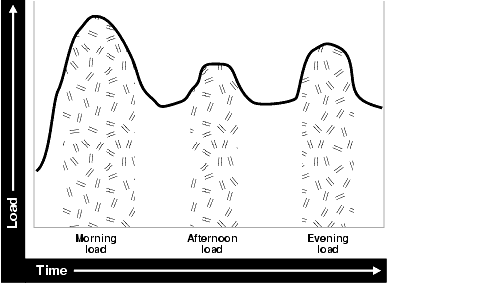10g (9.0.4)
Part Number B12118-01
Home |
Solution Area |
Contents |
Index |
| Oracle® Internet Directory Administrator's Guide 10g (9.0.4) Part Number B12118-01 |
|
Capacity Planning for the Directory, 3 of 8
The ability to assess the potential load on Oracle Internet Directory is very important for developing an accurate capacity plan. Let us examine the e-mail messaging software employed by our hypothetical company, Acme Corporation. The e-mail messaging software in this example is based on Internet Message Access Protocol (IMAP). There are two main types of software that access Oracle Internet Directory:
Let us assume that the private aliases and private distribution lists of individual users are also stored in the directory. Let us further make the following assumptions, which will allow us to guess the size of the directory:
Based on these assumptions, we can derive the overall count of entries in Oracle Internet Directory as:
These assumptions will yield a directory population of about one million entries. Given the user population and the directory population, let us then analyze usage patterns so that we can derive performance requirements from them. A typical user tends to send an average of 10 e-mails everyday and receives an average of 10 e-mails a day from the outside world. Assuming that there are, on an average, five recipients for each e-mail being sent by a user, this would result in five directory lookups for each e-mail.
The following table summarizes all the possible directory lookups that can happen in one day:
Summing up, the total number of directory lookups everyday would be about 3,200,000 (3.2 million) directory lookups everyday. If these directory lookups were spread out uniformly along the day, it would require about 37 directory lookups every second (133,333 lookups every hour). Unfortunately, we will never have this case.
Usage analysis of the current e-mail system over a period of 24 hours shows the pattern illustrated in Figure 20-1.

The e-mail system and Oracle Internet Directory are maximally stressed in the mornings. There are other usage peaks as well--one close to lunch time, and one near the end of business day. However, it is in the mornings that the Oracle Internet Directory is stressed the most.
Let us assume that 90 percent of all the directory lookups happen during normal working hours. Let us now split up the working hour load into the following categories for an 8 hour workday:
These calculations indicate that the Oracle Internet Directory in this case should be designed to handle the peak load of 936,000 lookups every hour.
Now that we know the data-set size as well as the performance requirements, we can now look into individual components of the installation and estimate good values for each.
|
|
 Copyright © 1999, 2003 Oracle Corporation. All Rights Reserved. |
|